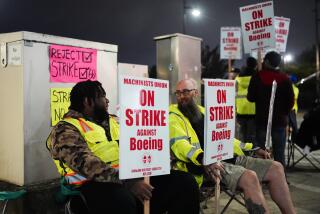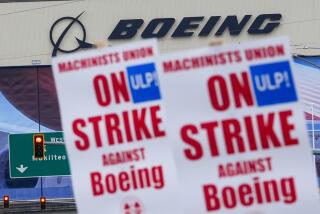Auto Workers, Ford Seek to Wrap Up Negotiations--Amicably
- Share via
DETROIT — Despite expectations for an early settlement, negotiators for the United Auto Workers and Ford Motor Co. were still talking late Friday in a bid to reach agreement on a new contract before the current one expires at midnight tonight.
The talks, which could yield a precedent-setting provision on minimum employment levels in auto factories, are widely expected to be amicably settled without a strike.
“The bargaining environment is still very positive,” said David Andrea, an analyst with Roney & Co. in Detroit. “Neither side is digging in.”
While most issues have been settled, the two sides are still hammering out agreements on the sticky issues of job security and contracting work to outside suppliers, as well as economic issues such as wages and pensions.
The union is pressing the auto maker to agree to keep employment at current levels, now about 104,000. And Ford for the first time is likely to agree to some minimum level. It is not clear what level of employment would be guaranteed, though sources said Ford is proposing about 85% of current levels.
That approach is attractive to the UAW because it protects current workers as well as maintains union membership, but it also allows Ford to cut its labor costs. More than 30,000 UAW members are expected to retire in the next few years, and they can be replaced with new hires at lower wage rates.
Under the current contract, new hires are paid 70% of scale and achieve parity in three years. Ford would like an even lower starting salary and longer catch-up period, but the union opposes the change.
Labor analysts said it is difficult to assess the importance of the minimum employment provision without seeing the contract language. It is likely to include some leeway, such as providing exceptions in case of recession.
“The devil will be in the details,” said Harley Shaiken, a labor professor at UC Berkeley.
The tenor of the triennial contract negotiations has been unusually temperate since talks began in June.
UAW President Stephen Yokich even declined to pick a strike target and instead undertook concurrent negotiations with the chief executives of Ford, Chrysler Corp. and General Motors Corp. He then quietly tapped Ford as the lead bargainer but continued less intensive talks with its two rivals.
Yokich has also hinted that the union will be more flexible in crafting a pattern agreement. While the Big Three will be given the same offer on wages and benefits, the UAW is likely to give them leeway on issues that would affect work rules and employment levels.
That is especially critical to GM, which, unlike Ford and Chrysler, needs drastic change to become competitive. Analysts say GM must trim its work force by 50,000 or more, and it is likely to resist a minimum employment formula that prevents it from becoming more efficient.
“GM could choke on this,” said Sean McAlinden, labor economist for the University of Michigan.
The UAW is also pushing for a wage increase of at least 2% a year for the length of the contract, sweetened pension benefits and reductions in outsourcing, the practice of shifting work to outside suppliers.
Ford may agree to bring some work back in-house as well as encourage its suppliers not to resist UAW organizing.
Once a tentative deal is reached with Ford, the union must decide whether to turn its attention to Chrysler or GM next. That decision could be influenced by the Canadian Auto Workers, who are threatening to strike Chrysler on Tuesday.






